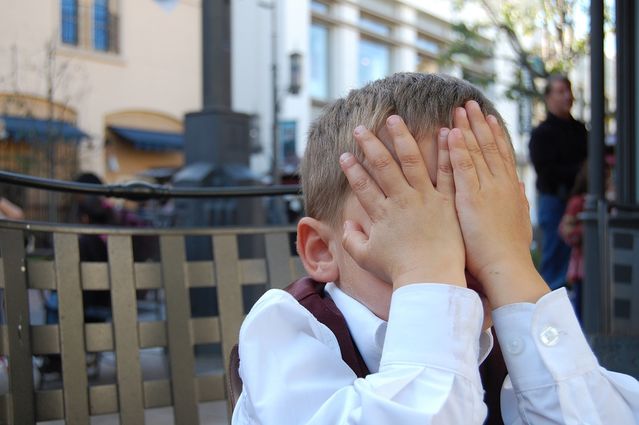Embarrassment
The Psychology of Embarrassment, Shame, and Guilt
The difference between three critical feelings.
Posted August 26, 2014 Reviewed by Kaja Perina

'Embarrassment’ is often used interchangeably with ‘shame.' Although there is some overlap, embarrassment and shame are distinct constructs.
Embarrassment is the feeling of discomfort experienced when some aspect of ourselves is, or threatens to be, witnessed by or otherwise revealed to others, and we think that this revelation is likely to undermine the image of ourselves that we seek to project to those others. Potential sources of embarrassment include particular thoughts, feelings, or dispositions; actions or behaviours such as belching or nose picking; conditions or states such as a bodily blemish or an open fly; possessions such as our car or house; and relations such as our oafish partner, criminal uncle, lecherous aunt, or insolent child. Sources of embarrassment need not be beneath our projected image, but merely out of keeping with it—which explains why it is possible to be embarrassed by our posh parents or rarefied education.
Shame
Whereas embarrassment is a response to something that threatens our projected image but is otherwise morally neutral, shame is a response to something that is morally wrong or reprehensible. Shame is normally accentuated if its object is exposed, but, unlike embarrassment, also attaches to a thought or action that remains undisclosed and undiscoverable to others. Embarrassment can be intense, but shame is a more substantial feeling in that it pertains to our moral character and not merely to our social character or image.
Shame arises from measuring our actions against moral standards and discovering that they fall short. If our actions fall short and we fail to notice, we can ‘be shamed’ or made to notice. If, having been made to notice we do not much mind, we can be said to be shameless or to ‘have no shame’. In the Nicomachean Ethics, Aristotle points out that shame also arises from lacking in honourable things shared by others like us, especially if the lack is our own fault and therefore owes to our moral badness. Finally, it is possible to feel shame vicariously, that is, to share in the shame of another person or feel shame on his behalf, particularly if he is closely allied or associated with us. Thus, even virtuous people with no personal cause for it can experience shame, and so much is also true of embarrassment and other emotions. ‘Hell,’ said Jean-Paul Sartre, ‘is other people.’
‘Shame’ derives from ‘to cover’, and is often expressed by a covering gesture over the brow and eyes, a downcast gaze, and a slack posture. Other manifestations of shame include a sense of warmth or heat and mental confusion or paralysis. These signs and symptoms can communicate remorse and contrition, and inspire pity and pardon. Nonetheless, we may prefer to make a secret of our shame, for shame can in itself be shameful—or, to be more precise, embarrassing.
People with low self-esteem are more prone to shame, because, having a poor self-image, they are harsher upon themselves. In some cases, they may defend against shame with blame or contempt, often for the person who incited their shame. Ultimately, this is likely to lead to even deeper shame, and so to even lower self-esteem. While overwhelming shame can be destructive, mild or moderate shame is mostly a force for good, spurring us on to lead more ethical lives.
Guilt pertains to an action or actions, and to blame and remorse: Shame says, “I am bad.” Guilt says, “I did something bad.” More subtly, shame involves falling short of cultural or societal moral standards, whereas guilt involves falling short of one’s own moral standards. Thus, it is entirely possible to feel guilty about actions of which many or most of our peers approve, such as living in luxury, driving an SUV, or eating meat.
Shame and guilt often go hand in hand, which is why they are often confused. For instance, when we injure someone, we often feel bad about having done so (guilt), and, at the same time, feel bad about ourselves (shame). Yet, guilt and shame are distinct emotions. Shame is ego dystonic, that is, in conflict with our self-image and the needs and goals of our ego, and high levels of shame are correlated with poor psychological functioning. In particular, eating disorders and many sexual disorders can largely be understood as disorders of shame, as can narcissism, which is sometimes thought of as a defense against shame. Guilt on the other hand is ego syntonic, that is, consistent with our self-image and the needs and goals of our ego, and, unless left to fester, is either unrelated or inversely correlated with poor psychological functioning.
Faced with the same set of circumstances, people with high self-esteem are more prone to guilt than to shame, and more likely to take corrective or redemptive action.
Neel Burton is author of Heaven and Hell: The Psychology of the Emotions and other books.


